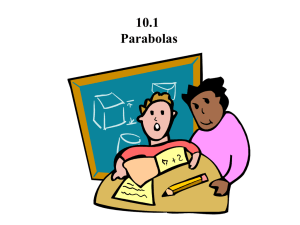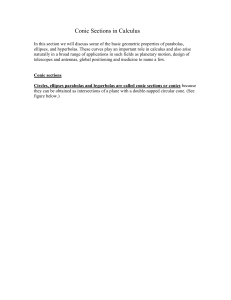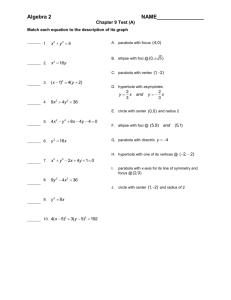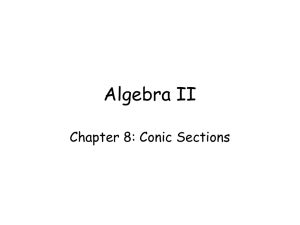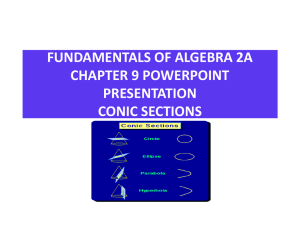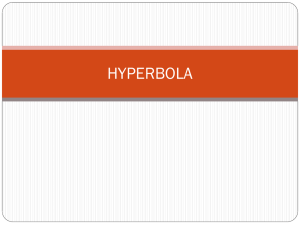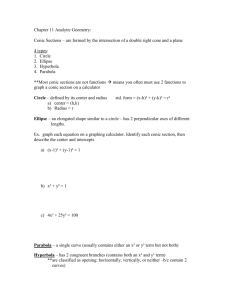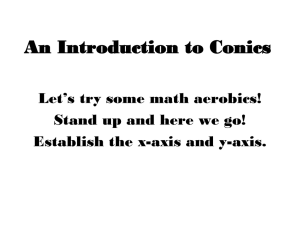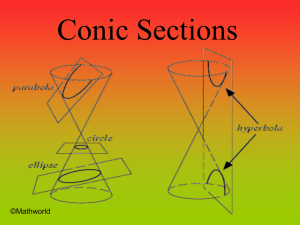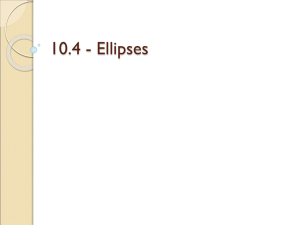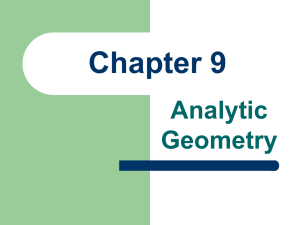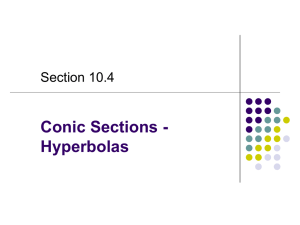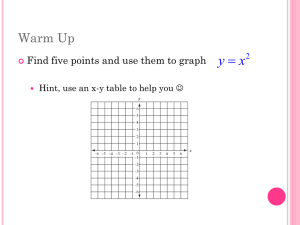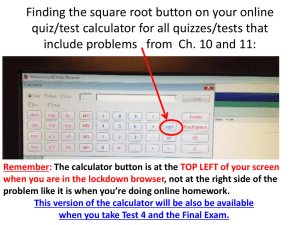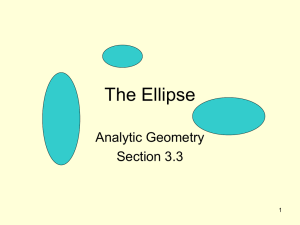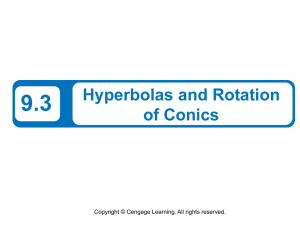Chapter 7 Analyzing Conic Sections
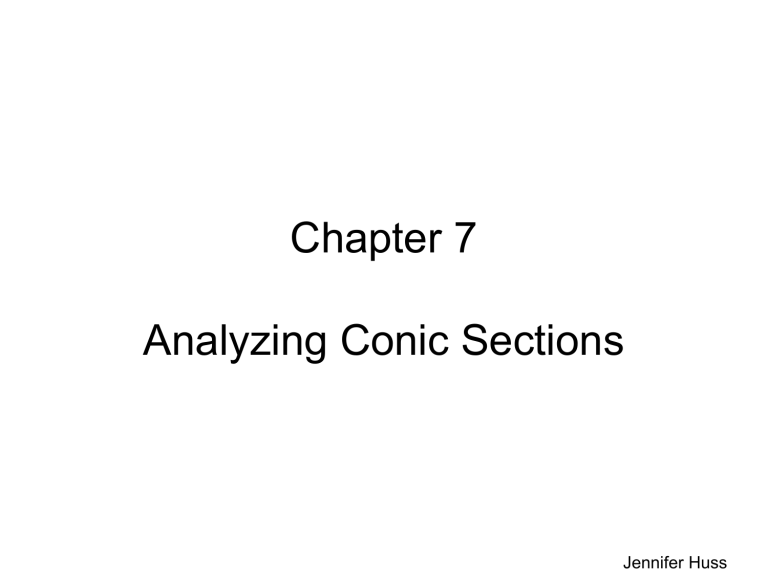
Chapter 7
Analyzing Conic Sections
Jennifer Huss
7-1 The Distance and Midpoint
Formulas
• To find the distance between any two points (a, b) and (c, d), use the distance formula:
Distance = (c – a) 2 + (d – b) 2
• The midpoint of a line is halfway between the two endpoints of a line
• To find the midpoint between (a, b) and (c, d), use the midpoint formula:
Midpoint =
(a + c)
,
(b + d)
2 2
7-1 Example
Find the distance between (-4, 2) and (-8, 4). Then find the midpoint between the points.
Distance = [(-8) – (-4)] 2 + (4 – 2) 2
Distance = (-8 + 4) 2 + (2) 2
Distance = (-4) 2 + (2) 2
Midpoint = (-4) + (-8) , 2 + 4
2 2
Midpoint = -12 , 6
2 2
Distance = 16 + 4
Distance= 20 Midpoint = ( -6, 3)
7-1 Problems
1. Find the distance between (0, 1) and (1, 5).
2. Find the midpoint between (6, -5) and (-2, -7).
3. Find the value for x if the Distance = 53 and the endpoints are (-3, 2) and (-10, x).
4. If you are given an endpoint (3, 2) and midpoint (-1, 5), what are the coordinates of the other endpoint?
8) (-5, 4) = 4 0 or x x = 3) (2, -6) 2) 1) 17
7-2 Parabolas
• A parabola is a set of points on a plane that are the same distance from a given point called the focus and a given line called the directrix
• The axis of symmetry is perpendicular to the directrix and passes through the parabola at a point called the vertex
• The latus rectum goes through the focus and is perpendicular to the axis of symmetry
• If the equation of the parabola begins with x= then the parabola is not a function (fails the vertical line test)
Axis of
Symmetry Parabola
Vertex
Focus
Latus
Rectum
Directrix
7-2 Parabolas (cont.)
Important Information About the
Parabolas y = a (x
– h) 2 + k x = a (y
– k) 2 + h Form of the equation
Axis of
Symmetry
Vertex
Focus x = h
(h, k)
(h, k + 1/4a)
Directrix
Direction of
Opening
Length of Latus
Rectum y = k – (1/4)a
Opens upward when a > 0 and downward when a < 0
1/a units y = k
(h, k)
(h + 1/4a, k) x = h – (1/4)a
Opens to the right when a > 0 and to the left when a < 0
1/a units
7-2 Example
Write y = x 2 + 4x + 1 in the form y = a (x – h) 2 + k and name the vertex, axis of symmetry, and the direction the parabola opens.
You can always check your answers by graphing.
y = x 2 + 4x + 1 y = (x 2 + 4x + o ) + 1 – o y = (x 2 + 4x + 4) + 1 – 4 y = (x + 2) 2 – 3
Vertex: (-2, -3)
Axis of Symmetry: x = -2
The parabola opens up because a = 1 so a > 0.
7-2 Problems
1.
Graph the equation x 2 = 8y.
2.
For the parabola y 2 = -16x name the vertex, focus, length of latus rectum, and direction of opening. Also, give the equations of the directrix and axis of symmetry.
3.
Given the vertex (4, 1) and a point on the parabola
(8, 3), find the equation of the parabola.
0 y = ry: met ym s is of
#2
Graph for
4 Ax = : x trix Direc t
2
lef
+ 1 –4) irection:
(1/8)(x
D
=
: 16
3) y tum us rec 0) Lat -4, : ( ocus 0) F : (0, ertex 2) V
#1
Graph for
7-3 Circles
• A circle is a set of points equidistant from a center point
• The radius is a line between the center and any point on the circle
• The equation of a circle is
(x – h) 2 + (y – k) 2 = r 2 where the radius is r and the vertex is
(h, k)
• Sometimes you need to complete the square twice to get the equation in this form
(once for x and once for y)
Vertex
(k, h)
Radius (r)
7-3 Examples
1.
Find the center and radius of x 2 + y 2 + 4x – 12y – 9 = 0 and then graph the circle.
x 2 + 4x + o
+ y 2 – 12y + o
= 9 + o
+ o x 2 + 4x + 4 + y 2 – 12y + 36 = 9 + 4 + 36
(x + 2) 2 + (y – 6) 2 = 49
Radius = 7 and Center is (-2, 6)
7-3 Examples (cont.)
2.
If a circle has a center (3, -2) and a point on the circle
(7, 1), write the equation of the circle.
Find the radius by the distance formula.
Radius = (7 – 3) 2 + (1 – (-2)) 2 r = (4) 2 + (3) 2 r = 16 + 9 r = 25 r = 5
The equation of the circle will be (x – 3) 2 + (y + 2) 2 = 25
7-3 Problems
1.
Find the center and radius of x 2 + y 2 + 4y = 0. Then graph the circle.
2.
If a circle has a center (0, 0) and a point on the circle
(-2, -4) write the equation of the circle.
= 20
2
+ y
2
2) x 2 and Radius -2) Center (0, = 4
2
2) + + (y
2
1) x #1
7-4 Ellipses
• An ellipse is the set of all points in a plane such that the sum of the distances from the foci is constant
• An ellipse has two axes of symmetry
• The axis of the longer side of the ellipse is called the major axis and the axis of the shorter side is the minor axis
• The focus points always lie on the major axis
• The intersection of the two axes is the center of the ellipse
Major Axis
Focus
Center
Focus
Minor
Axis
7-4 Ellipses (cont.)
Equation of the Ellipse
(x – h) 2 + (y – k) 2 a 2 b 2
= 1
Foci Points
Is the major axis horizontal or vertical?
( h + c, k) and
(h
– c, k)
Horizontal
Center of the
Ellipse
(h, k)
(x – h) 2 + (y – k) 2 b 2 a 2
= 1
(h, k + c) and
(h, k
– c)
Vertical
Important Notes :
• In the above chart, c = a 2 – b 2
(h, k)
• a 2 > b 2 always so a 2 is always the larger number
•If the a 2 is under the x term, the ellipse is horizontal, if the a 2 is under the y term the ellipse is vertical
•You can tell that you are looking at an ellipse because: x 2 is added to y 2 and the x 2 and y 2 are divided by different numbers (if numbers were the same, it’s a circle)
7-4 Example
1.
Given an equation of an ellipse 16y 2 + 9x 2 – 96y – 90x = -225 find the coordinates of the center and foci as well as the lengths of the major and minor axis. Then draw the graph.
16 (y 2 – 6y + o
) + 9 (x 2 – 10x + o
) = -225 + 16 ( o
) + 9( o
)
16 (y 2 – 6y + 9) + 9 (x 2 – 10x + 25) = -225 + 16(9) + 9(25)
16 (y – 3) 2 + 9 (x – 5) 2 = 144
(y – 3) 2 + (x – 5) 2
= 1
9 16
Center: (5, 3)
16 > 9 so the foci are on the vertical axis c = 16 – 9 c = 7
Foci: ( 5 + 7, 3) and (5 – 7, 3)
Major Axis Length = 4 (2) = 8
Minor Axis Length = 3 (2) = 6
7-4 Problems
1.
For 49x 2 + 16y 2 = 784 find the center, the foci, and the lengths of the major and minor axes. Then draw the graph.
2.
Write an equation for an ellipse with foci (4, 0) and
(-4, 0). The endpoints of the minor axis are (0, 2) and
(0, -2).
8 minor= Length of major= 14
= 1
2
4
+ y
Length of
2
X
0)
20
2)
Center: (0, 33) 33) (0, Foci: (0, 1)
#1
7-5 Hyperbolas
• A hyperbola is a set of all points on a plane such that the absolute value of the difference (subtraction) of the distances from a point to the two foci is constant
• The center is the midpoint of the segment connecting the foci
• The vertex is the point on the hyperbola closest to the center
• The asymptotes are lines the hyperbola can approach but never touch
• The transverse axis goes through the foci
• The conjugate axis is perpendicular to the transverse axis at the center point
Hyperbola
Conjugate
Axis
Transverse
Axis
Center Focus
Vertex
Asymptotes
7-5 Hyperbolas (cont.)
Equation of Hyperbola
(x
(y
– h) a
– k)
2
2
_ (y
2
_ (x
– k) a 2 b b
2
2
– h)
2
2
= 1
= 1
Center
(h, k) (h
– c, k) and (h
+ c, k)
(h, k)
Foci Points
(h, k – c) and
(h, k + c)
(c = a 2 + b 2 )
Equation of
Asymptote
Vertex Transverse
Axis y = +/- (b/a) x (h +a, k) and
(h – a, k)
Horizontal y = +/- (a/b) x (h, k + a) and
(h, k
– a)
Vertical
You must be looking at a hyperbola because the x 2 and y 2 terms are subtracted
(x 2 – y 2 ) or (y 2 – x 2 )
7-5 Example
Write the standard form of the equation of the hyperbola
144y 2 – 25x 2 – 576y – 150x = 3249. Then find the coordinates of the center, the vertices, the foci, and the equation of the asymptotes. Graph the hyperbola and the asymptotes.
144(y 2 – 4y + o
)
– 25(x 2 + 6x + o
) = 3249 + 144( o
) + 25( o
)
144(y 2 – 4y + 4) – 25(x 2 + 6x + 9) = 3249 + 144(4) + 25(9)
144(y – 2) 2 – 25(x + 3) 2 = 3600
(y-2) 2 _ (x + 3) 2
25 144
= 1
Center: (-3, 2) a = 5 so the vertices are (-3, 7) and (-3, -3) a 2 + b 2 = c 2
25 + 144 = c 2 c = 13
The foci are (-3, 15) and (-3, -11).
7-5 Example (cont.)
Asymptotes have the formula y = +/- a/b x and we have center (-3, 2) and slopes +/- 5/12.
y
– 2 = 5/12 (x + 3) y – 2 = (5/12) x + 15/12 y = (5/12) x + 13/4 y y
– 2 = -5/12 (x + 3)
– 2 = (-5/12) x + -15/12 y = (-5/12) x + 3/4
7-5 Problems
Find the coordinates of the vertices and the foci. Give the asymptote slopes for each hyperbola. Then draw the graph.
1) x 2 _ y 2
9 49
= 1
2) 25x 2 – 4y 2 = 100
7/3
-5/2
+/ope = +/
Slope =
Sl
0)
29, 0)
58, (
(-
58, 0)
29, 0)
-
Foci: (
Foci: (
0)
0)
0) (2,
0) (3,
-2,
-3, es: ( es: (
Vertic
Vertic
2)
1)
2) 1)
7-6 Conic Sections
• Circles, ellipses, parabolas, and hyperbolas are all formed when a double cone is sliced by a plane
• The general equation of any conic section is :
Ax 2 + Bxy + Cy 2 + Dx + Ey + F = 0
• The standard equations for each specific conic section are listed in previous sections
• If B = 0 and you look at A and C in the equations:
Relationship of A and C Conic Section
Name
Parabola
Circle
Ellipse
Hyperbola
A = 0 or C= 0, but never both equal to 0
A = C
A and C have the same sign, but A = C
A and C have opposite signs
7-6 Example
Identify 9x 2 + 16y 2 – 54x + 64y + 1 = 0 as one of the four conic sections. Then graph the conic section.
9x 2 + 16y 2 – 54x + 64y = -1
9 (x 2 – 6x + o ) + 16(y 2 + 4y + o ) = -1 + 9( o ) + 16( o )
9 (x 2 – 6x + 9) + 16(y 2 + 4y + 4) = -1 + 9(9) + 16(4)
9(x – 3) 2 + 16(y + 2) 2 = 144
(x
– 3) 2 (y + 2) 2
+
16 9
= 1
This conic section is an ellipse.
7-6 Problems
Write the equation in standard form and decide if the conic section is a parabola, a circle, an ellipse, or a hyperbola. Then graph the equation.
1) x 2 + y 2 + 6x = 7
2) 5x 2 – 6y 2 – 30x – 12y + 9 = 0 hyperbola
= 1
2
1)
5
+ _ (y
2
6
(x –3) 2) ircle c = 16
2
) + (y
2
3) + 1) (x 2) 1)
7-7 Solving Quadratic Systems
• When you solve a system of quadratic equations the method is almost the same as solving a system of linear equations
• If the system has one equation of a conic section and one equation of a straight line, you can get zero, one, or two solutions to the system
• If both the equations are conic sections, the system should have zero, one, two, three, or four solutions
7-7 Example
Solve this system of equations using algebraic methods and by graphing the equations.
y = (x – 2) 2 + 1 y = -4x + 5
Set the equations equal to each other to solve for x.
-4x + 5 = (x
– 2) 2 + 1
-4x + 5 = x 2 – 4x + 4 + 1
-4x + 5 = x 2 – 4x + 5
5 = x 2 + 5 x 2 = 0 x = 0
The system of equations has one solution, (0, 5) . The graphs of these equations confirms this.
Then put x = 0 back in to solve for y.
y = -4(0) + 5 y = 5
7-7 Problems
Solve these systems of equations by using algebra and graphing the equations.
1) 4x 2 + y 2 = 25
2x 2 – y 2 = -1
2) x 2 + y y = x 2
2 = 10
– 4
2) } 6, ( 2) 6, 3) ( 1, 3) ((1, : { olutions our s 2) F } -3) (-2, 2, 3) 3) ((2, (2, 3) : { olutions our s 1) F
